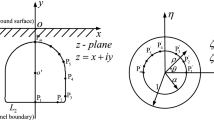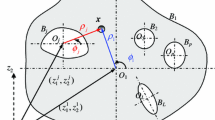Abstract
The paper considers the problem of determining the eigenfrequencies of biconical cavity making it possible to simplify the eigenfrequency-based design of devices. We used the solving of the excitation problem for biconical cavity using the method of partial intersecting regions in combination with the collocation method. Based on the concept of the search of quasisolution for determining eigenfrequencies, it was proposed to apply the fractionally rational approximation of cavity response obtained as a result of solving the problem of resonator excitation. The efficiency of finding eigenfrequencies of biconical cavity was substantiated by using the fractionally rational approximation based on the chain fraction interpolation of cavity response calculated only at collocation points. Using the above approach, we have obtained the relationship of eigenfrequencies of azimuth-symmetric oscillations of biconical cavity as a function of the aperture angle, and the typing of lower azimuth-symmetric transverse electric modes of biconical cavity has been performed.
Similar content being viewed by others
References
A. L. Cullen, “Millimeter-wave open-resonator techniques,” Infrared and Millimeter Waves10, 233 (1983).
M. N. Afsar, K. J. Button, “Millimeter-wave dielectric measurement of materials,” Proc. IEEE73, No. 1, 131 (1985). DOI: https://doi.org/10.1109/PROC.1985.13114.
I. K. Kuzmichev, P. N. Melezhik, A. Ye. Poyedinchuk, “An open resonator for physical studies,” Int. J. Infrared Millimeter Waves27, No. 6, 857 (2006). DOI: https://doi.org/10.1007/s10762-006-9122-7.
I. K. Kuzmichev, A. Yu. Popkov, “Resonant systems for measurement of electromagnetic properties of substances at V-band frequencies,” in: Emerging Microwave Technologies in Industrial, Agricultural, Medical and Food Processing (IntechOpen, London, 2018), Ch. 3, pp. 27–53. URI: https://www.intechopen.com/books/emerging-microwave-technologies-in-industrial-agricultural-medical-and-food-processing/resonant-systems-for-measurement-of-electromagnetic-properties-of-substances-at-v-band-frequencies.
T. Karpisz, B. Salski, P. Kopyt, J. Krupka, “Measurement of dielectrics from 20 to 50 GHz with a Fabry-Pérot open resonator,” IEEE Trans. Microwave Theory Tech.67, No. 5, 1901 (2019). DOI: https://doi.org/10.1109/TMTT.2019.2905549.
Yu. V. Kovtun, I. B. Pinos, A. N. Ozerov, A. I. Skibenko, E. I. Skibenko, V. B. Yuferov, “Microwave device on the basis of a barrel resonator for determining the average density and the density profile in plasma formations,” Ukrainian J. Phys.60, No. 11, 1101 (2015). DOI: https://doi.org/10.15407/uipe60.11.1101.
A. Rashidian, L. Shafai, D. Klymyshyn, C. Shafai, “A fast and efficient free-space dielectric measurement technique at mm-wave frequencies,” IEEE Antennas Wireless Propag. Lett.16, 2630 (2017). DOI: https://doi.org/10.1109/LAWP.2017.2737632.
D. P. Burtovoi, V. L. Mironenko, A. I. Tereshchenko, “Application of open cylindrical evanescent-mode resonator for investigating the dielectric properties of matter,” Izv. Vyssh. Ucheb. Zaved, Radioelek.13, No. 9, 1085 (1970).
P. Nagenthiram, A. L. Cullen, “A microwave barrel resonator for permittivity measurements on dielectric rods,” Proc. IEEE62, No. 11, 1613 (1974). DOI: https://doi.org/10.1109/PROC.1974.9674.
M. V. Andreev, O. O. Drobakhin, Ye. N. Privalov, D. Yu. Saltykov, “Measurement of dielectric material properties using coupled biconical resonators,” Telecommun. Radio Eng.73, No. 11, 1017 (2014). DOI: https://doi.org/10.1615/TelecomRadEng.v73.i11.70.
A. A. Alimov, A. A. Radionov, “The open limit biconical resonator calculation,” Antennas, No. 4, 40 (2015). URI: https://elibrary.ru/item.asp?id=23366163.
B. Z. Katsenelenbaum, L. Mercader del Rio, M. Pereyaslavets, M. Sorolla Ayza, M. Thumm, Theory of Nonuniform Waveguides: The Cross-Section Method (IEE, London, 1998). DOI: https://doi.org/10.1049/PBEW044E.
J. P. Van’t Hof, D. D. Stancil, “Eigenfrequencies of a truncated conical resonator via the classical and Wentzel-Kramers-Brillouin methods,” IEEE Trans. Microwave Theory Tech.56, No. 8, 1909 (2008). DOI: https://doi.org/10.1109/TMTT.2008.927408.
D. B. Kuryliak, Z. T. Nazarchuk, O. B. Trishchuk, “Axially-symmetric TM-waves diffraction by sphere-conical cavity,” PIER B73, 1 (2017). DOI: https://doi.org/10.2528/PIERB16120904.
D. B. Kuryliak, O. M. Sharabura, “Diffraction of axially-symmetric TM-wave from bi-cone formed by finite and semi-infinite shoulders,” PIER B68, 73 (2016). DOI: https://doi.org/10.2528/PIERB16041302.
K. G. Savin, I. P. Golubeva, Yu. V. Prokopenko, “Calculation of frequency and power characteristics of the composite metal-dielectric resonator using the method of partial regions,” Radioelectron. Commun. Syst.59, No. 5, 229 (2016). DOI: https://doi.org/10.3103/S0735272716050058.
I. G. Prokhoda, V. P. Chumachenko, “The method of partial intersecting domains for the investigation of waveguide-resonator systems having a complex shape,” Radiophys. Quantum Electron.16, 1219 (1973). DOI: https://doi.org/10.1007/BF01031224.
R. H. W. Hoppe, Yu. A. Kuznetsov, “Overlapping domain decomposition methods with distributed Lagrange multipliers,” J. Numerical Math.9, No. 1, 285 (2001). DOI: https://doi.org/10.1515/JNMA.2001.285.
O. O. Drobakhin, P. I. Zabolotnyy, Ye. N. Privalov, “Approximate calculation of eigenfrequencies of biconical microwave cavities,” Radioelectron. Commun. Syst.56, No. 3, 127 (2013). DOI: https://doi.org/10.3103/S0735272713030035.
M. V. Andreev, O. O. Drobakhin, D. Yu. Saltykov, N. B. Gorev, I. F. Kodzhespirova, “Simple technique for biconical cavity eigenfrequency determination,” Radioelectron. Commun. Syst.60, No. 12, 555 (2017). DOI: https://doi.org/10.3103/S0735272717120056.
M. V. Andreev, O. O. Drobakhin, D. Yu. Saltykov, “Determination of the resonance frequency and the Q-factor of a half-disk dielectric resonator using fractional rational approximation,” Radio Phys. Radio Astron.18, No. 4, 362 (2013). URI: http://rpra-iournal.org.ua/index.php/ra/article/view/1157.
Author information
Authors and Affiliations
Corresponding authors
Additional information
Conflict of Interest
The authors declare that they have no conflict of interest.
Additional Information
The initial version of this paper in Russian is published in the journal “Izvestiya Vysshikh Uchebnykh Zavedenii. Radioelektronika,” ISSN 2307-6011 (Online), ISSN 0021-3470 (Print) on the link http://radio.kpi.ua/article/view/S0021347019120033 with DOI: https://doi.org/10.20535/S0021347019120033.
Russian Text © The Author(s), 2019, published in Izvestiya Vysshikh Uchebnykh Zavedenii, Radioelektronika, 2019, Vol. 62, No. 12, pp. 737–749.
About this article
Cite this article
Andreev, M.V., Drobakhin, O.O., Saltykov, D.Y. et al. Determination of Biconical Cavity Eigenfrequencies Using Method of Partial Intersecting Regions and Approximation by Rational Fractions. Radioelectron.Commun.Syst. 62, 630–641 (2019). https://doi.org/10.3103/S0735272719120033
Received:
Revised:
Accepted:
Published:
Issue Date:
DOI: https://doi.org/10.3103/S0735272719120033




